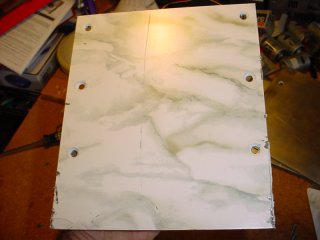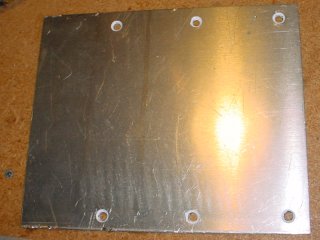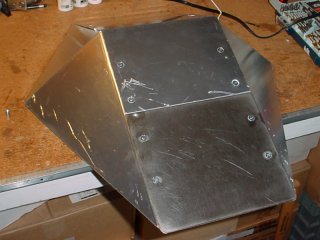CSM 3.1 POST BATTLE INSPECTION
[12/07/2004]
The CSM Robotics 3.0 Robot Rumble was held on Sunday, December 5, 2004. It was for the
current students of the CSM Robotics class to try out their robots in actual combat situations.
My robot engaged in three battles, each of which involved a robot with a spinning weapon.
I had a good time scooping up my opponents and pushing them into the walls, but overall, I
didn't want to be too aggressive, because I didn't want to see any of our robots become
severely damaged or disabled. We all put a lot of work into our robots, and these battles were
proving grounds to see how the robots performed and to give us a chance to make changes and
fine-tuning adjustments. So, I basically did not make an effort to hit an opponent who was
no longer moving, even though a few of the spectators seemed to want me to.
With that said, I wanted to thoroughly inspect my robot after the event and to take notes
about what happened during the event so I can take steps to improve my robot and my practices,
so I wasted no time dismantling my robot the following day. You can click on any of the
images below to see a larger version. Yes - you really will see a LARGER version (unlike
some web sites).
 The rear panel did not see much action, but it did see some. I noticed on all panels that the
edges took the brunt of the "damage", so anywhere the con-tact paper was wrapped around an edge,
it pretty much got torn off (more like scraped off). An inspection of this rear plate indicates
that I could probably benefit from replacing it with Titanium, as it can and does take some
secondary hits after an initial hit from a spinner swings the robot around. I also had an
occasion or two to back into my opponents. Therefore, Titanium would add some beneficial
protection to this side as well (since I have no weapon), especially the lower part of the
plate near the ground.
The rear panel did not see much action, but it did see some. I noticed on all panels that the
edges took the brunt of the "damage", so anywhere the con-tact paper was wrapped around an edge,
it pretty much got torn off (more like scraped off). An inspection of this rear plate indicates
that I could probably benefit from replacing it with Titanium, as it can and does take some
secondary hits after an initial hit from a spinner swings the robot around. I also had an
occasion or two to back into my opponents. Therefore, Titanium would add some beneficial
protection to this side as well (since I have no weapon), especially the lower part of the
plate near the ground.
 The con-tact paper did a fair job of minimizing scratches on the actual metal where the force
of contact was minimal. Very few actual scratches were visible after removing the covering.
That, to me, is one benefit of covering the robot with the Con-tact paper.
The con-tact paper did a fair job of minimizing scratches on the actual metal where the force
of contact was minimal. Very few actual scratches were visible after removing the covering.
That, to me, is one benefit of covering the robot with the Con-tact paper.
 The top plate took the most severe damage. This was a clear indication that the Titanium
plate I added was no big enough. I had envisioned that a spinning weapon or robot would be
deflected by the Titanium plate and just kind of skim off the front of the top plate. But at
one point, I think I got under the base of my opponent before I had a chance to slow down its
weapon, allowing the weapon to strike higher up, into the aluminum top plate. There are two
very deep gouges (one pierced all the way through) on the left, and there is a significant
scar at the bottom near the right side. The lower one did deflect off the Titanium, but still
had plenty of energy left to just plow right thorough the aluminum (about half-way through).
The top plate took the most severe damage. This was a clear indication that the Titanium
plate I added was no big enough. I had envisioned that a spinning weapon or robot would be
deflected by the Titanium plate and just kind of skim off the front of the top plate. But at
one point, I think I got under the base of my opponent before I had a chance to slow down its
weapon, allowing the weapon to strike higher up, into the aluminum top plate. There are two
very deep gouges (one pierced all the way through) on the left, and there is a significant
scar at the bottom near the right side. The lower one did deflect off the Titanium, but still
had plenty of energy left to just plow right thorough the aluminum (about half-way through).
 Here, the back side of the top plate is shown, where the weapon penetrated it. The pimple to
the right of the hole is where the other twin gouge almose pierced through. Between the hole
and the pimple is the outline of the head of the bolt that sits beneath the top plate that
secures the right side panel in place. There was a divot in the metal next to this bolt as
well (not shown). But the interesting thing to me is that this hit was severe enough for the bolt
to leave an impression in the top plate.
Here, the back side of the top plate is shown, where the weapon penetrated it. The pimple to
the right of the hole is where the other twin gouge almose pierced through. Between the hole
and the pimple is the outline of the head of the bolt that sits beneath the top plate that
secures the right side panel in place. There was a divot in the metal next to this bolt as
well (not shown). But the interesting thing to me is that this hit was severe enough for the bolt
to leave an impression in the top plate.
 Here is the top plate with the Con-tact paper removed. Again, the appearance of damage and
scratches is minimized. The covering did a fair job of protecting the finish of the panel.
But with the covering removed, the deep wounds actually become more pronounced.
Here is the top plate with the Con-tact paper removed. Again, the appearance of damage and
scratches is minimized. The covering did a fair job of protecting the finish of the panel.
But with the covering removed, the deep wounds actually become more pronounced.
 The front plate saw most of the action, as anticipated. It was also the most dramatic
transformation when I removed the covering. You can see there are many scratches on this plate,
and the covering around the edges is basically gone. But there are no dents and no gouges in
this plate, because it is made of Titanium.
The front plate saw most of the action, as anticipated. It was also the most dramatic
transformation when I removed the covering. You can see there are many scratches on this plate,
and the covering around the edges is basically gone. But there are no dents and no gouges in
this plate, because it is made of Titanium.
 I love this stuff! Hardly a scratch is visible! I had a more difficult time removing the
covering from this piece, for a couple of reasons. One thing that made it challenging was that
it was so scratched up that the covering came off in smaller pieces. The other thing that made
it difficult is that the Con-tact paper seems to like to stick better to Titanium. I don't know
if that is because it is Titanium, or because I sanded the Titanium with a fine grain sandpaper
before applying the covering. I will have to do some experimentation.
I love this stuff! Hardly a scratch is visible! I had a more difficult time removing the
covering from this piece, for a couple of reasons. One thing that made it challenging was that
it was so scratched up that the covering came off in smaller pieces. The other thing that made
it difficult is that the Con-tact paper seems to like to stick better to Titanium. I don't know
if that is because it is Titanium, or because I sanded the Titanium with a fine grain sandpaper
before applying the covering. I will have to do some experimentation.
 The same was pretty much true all around. The scratches showed up prominately in the covering...
The same was pretty much true all around. The scratches showed up prominately in the covering...
 But once the covering was removed, the scratches appeared diminished. I am thinking Titanium
could be useful here as well, but I'm not sure how I would apply it (can Titanium be bent to a
desired shape?). However, the strikes on this side were due to an unfortunate incident where I
was unable to move the robot because the antenna was disconnected. Titanium would help protect
my robot if it is a sitting duck, dead in the water, but as long as I have control, I don't think
it is needed on the sides.
But once the covering was removed, the scratches appeared diminished. I am thinking Titanium
could be useful here as well, but I'm not sure how I would apply it (can Titanium be bent to a
desired shape?). However, the strikes on this side were due to an unfortunate incident where I
was unable to move the robot because the antenna was disconnected. Titanium would help protect
my robot if it is a sitting duck, dead in the water, but as long as I have control, I don't think
it is needed on the sides.
 The left side is a little different, however. It is difficult to see in these pictures, but
the left side has more pitted-type injuries. This is because the two spinners I went up against
both spun counter-clockwise (or anti-clockwise for those of you in or from the UK). Subsequently,
the spinning weapons would tend to approach from the left as my robot faced them. What I find
most interesting is that these pits are not very deep. I suspect this is because there was not
much opposing force to stop or deflect them -- if and when my robot got hit there, it simply spun
around. It is a long leverage arm from there to my wheels, so not much force is needed to swing
my robot from that point.
The left side is a little different, however. It is difficult to see in these pictures, but
the left side has more pitted-type injuries. This is because the two spinners I went up against
both spun counter-clockwise (or anti-clockwise for those of you in or from the UK). Subsequently,
the spinning weapons would tend to approach from the left as my robot faced them. What I find
most interesting is that these pits are not very deep. I suspect this is because there was not
much opposing force to stop or deflect them -- if and when my robot got hit there, it simply spun
around. It is a long leverage arm from there to my wheels, so not much force is needed to swing
my robot from that point.
 Again, the covering is removed to reveal the actual, minimized damage beneath. I would like to
add a piece of Titanium along the left side in the front, somehow, to protect against - and
perhaps to help deflect - approaching spinning weapons. I'd like to somehow implement some kind
of servo-controlled "doorstop" on the right side that I could drop down just before getting hit
to provide something for my opponents to bounce off of when they hit me on the left (I like it
when they knock themselves out).
Again, the covering is removed to reveal the actual, minimized damage beneath. I would like to
add a piece of Titanium along the left side in the front, somehow, to protect against - and
perhaps to help deflect - approaching spinning weapons. I'd like to somehow implement some kind
of servo-controlled "doorstop" on the right side that I could drop down just before getting hit
to provide something for my opponents to bounce off of when they hit me on the left (I like it
when they knock themselves out).
 A phenomenon that did not show up in early experiments was the sticky residue that was left
behind after removing the Con-tact paper. Apparently, the longer you leave the covering on,
the better it adheres to the surface. In early tests, I applied the covering on a test piece,
but then removed it shortly thereafter. It left no residue. Even on Titanium. But the covering
had been applied to most of the robot for several days and left behind a sticky film when
removed. The top panel was covered a couple hours before the battle and was removed the next
day, and I saw very little - if any - residue from that. The Titanium plate had been covered
the day before the battle, however, but seemed to leave the most residual sticky film behind.
Applying heat with the heat gun while removing the paper (from aluminum) only seemed to make
things a tiny bit worse, so I'm curious if applying cold air (or ice) might help.
A phenomenon that did not show up in early experiments was the sticky residue that was left
behind after removing the Con-tact paper. Apparently, the longer you leave the covering on,
the better it adheres to the surface. In early tests, I applied the covering on a test piece,
but then removed it shortly thereafter. It left no residue. Even on Titanium. But the covering
had been applied to most of the robot for several days and left behind a sticky film when
removed. The top panel was covered a couple hours before the battle and was removed the next
day, and I saw very little - if any - residue from that. The Titanium plate had been covered
the day before the battle, however, but seemed to leave the most residual sticky film behind.
Applying heat with the heat gun while removing the paper (from aluminum) only seemed to make
things a tiny bit worse, so I'm curious if applying cold air (or ice) might help.
 Here is the robot, reassembled, with all the covering removed. It doesn't look so beat up
anymore. There were quite a few sharp edges and corners around the pits and scratches, so I
used my Dremel tool to grind off all protrusions. The scratches are more pronounced, now, due
to the marks left behind from the grinding operation, but the robot is ready for a new layer of
Con-tact paper, which will hide all scars before the next battle. The next rumble is in January,
so I have some time to figure out what pattern I want to apply (perhaps granite this time, or
some green marble that I have). I won't apply the covering until the day before the rumble so
I won't have to spend so much time with the removal process, afterward. I love the fact that I
can give my robot a new look each time. Therein lies the deception!
Here is the robot, reassembled, with all the covering removed. It doesn't look so beat up
anymore. There were quite a few sharp edges and corners around the pits and scratches, so I
used my Dremel tool to grind off all protrusions. The scratches are more pronounced, now, due
to the marks left behind from the grinding operation, but the robot is ready for a new layer of
Con-tact paper, which will hide all scars before the next battle. The next rumble is in January,
so I have some time to figure out what pattern I want to apply (perhaps granite this time, or
some green marble that I have). I won't apply the covering until the day before the rumble so
I won't have to spend so much time with the removal process, afterward. I love the fact that I
can give my robot a new look each time. Therein lies the deception!
In summary, here are a few key points that were observed:
- I need to slow down - pace myself - in the pits when preparing for a fight. Refer to my check lists to ensure that I do not miss important details - like connecting the receiver antenna! Place a reminder that is VERY VISIBLE when the top plate is removed.
- Titanium on the back would be helpful in extending my defensive (and offensive!) options.
- Spinners tend to turn counter-clockwise - additional protection on the left side panel near the front (i.e. Titanium) would be welcome.
- There are too many bolts to undo to get to the batteries. A quick-release method of opening the shell would be great.
- Adjusting wheel height requires the removal of all armor panels. I need a way to adjust the wheel height by turning a screw through a hole in the bottom.
- The external antenna mount is very vulnerable. I need an alternative solution.